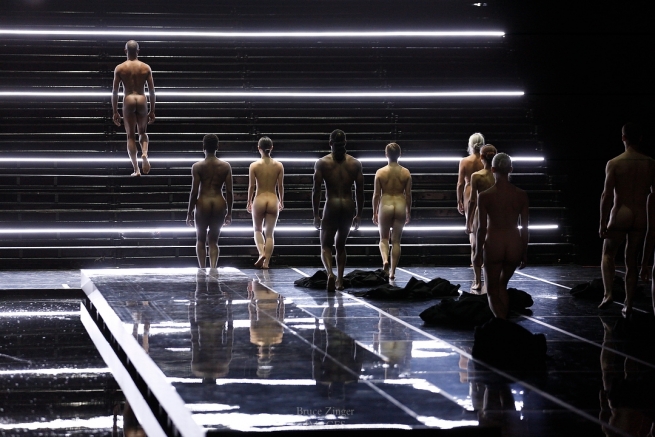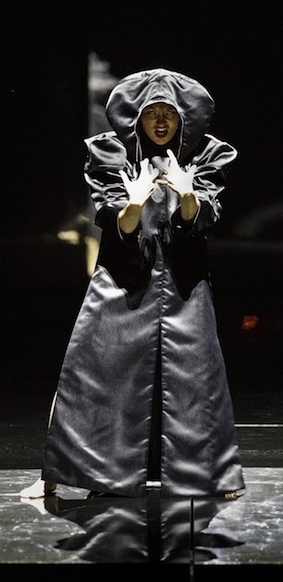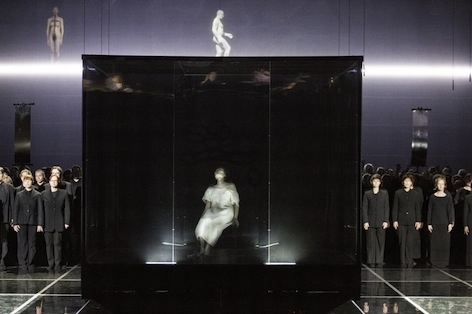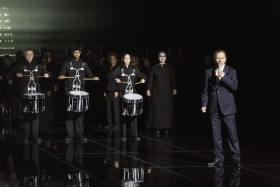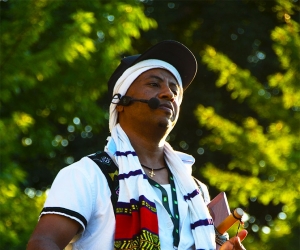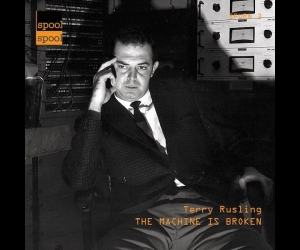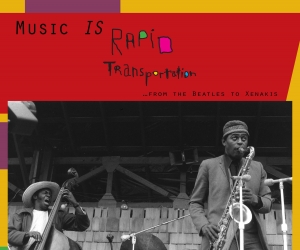I ATTENDED A PERFORMANCE of the Luminato Festival’s production of R. Murray Schafer’s Apocalypsis not knowing what to expect; the full version of this work had only been produced once, thirty-five years ago. After the performance, I obtained the scores for its two acts—John’s Vision and Credo—as well as recordings of both the early production and the one I attended. I also studied video fragments, available on the Web, of recent work by Auckland choreographer Lemi Ponifasio, who directed the Luminato production.
My desire to explore this work further stemmed from what I felt was an extreme disconnect between Schafer’s music—as performed by a cast of almost a thousand musicians—and certain aspects of the production, and from the following statement in the official program book, written by Luminato producer and executive director Jorn Weisbrodt: “Three years ago there was nothing: there was no cast; there was no set; there was no money; there was nothing to do this piece, just the idea, the score. There was only a desert with no glimpse of a piece.”
Like Handel’s Messiah or Haydn’s Creation, Apocalypsis is an oratorio—a long musical composition for orchestra, choir, and soloists. Imagine a producer of Messiah saying “There was nothing to do this piece, just the idea, the score.” In his writing, German composer Richard Wagner uses the term Gesamtkunstwerk (a total work of art), a concept that he applied to the production of his operas. Apocalypsis was composed in the mid ’70s, concurrent with the dawn of punk and the rise of heavy metal elsewhere in the music world; based on ecclesiastical sources but often punk-like, it is most definitely a gesamtkunstwerk. But in the Luminato production, Apocalypsis was not treated as such. The producer’s insult—considering this music to be, as his program notes suggest, incidental—was manifest in the casting choices. The flow of the music in the first half was often interrupted by gratuitous events and, in the latter half (Credo), by filling the stage with elements rehashed from Ponifasio’s recent works, while relegating the considerable musical forces to offstage accompaniment.
Schafer’s score is fascinating to see and read, containing a wealth of suggestive material. Schafer, who is arguably the world’s preeminent living composer of large-scale structured music in unusual settings, prescribes a colourful and chaotic pageant leading dramatically towards an end of times. The score for John’s Vision consists of large pages of very illustrative. often purely graphic lines, and shape poetry, which are intermingled with more conventional notation. There are also very specific staging instructions. After having directed the first production, the composer added a postscript of revisions, made during the course of the production, and suggestions for future versions.
I’ve experienced a few of Schafer’s other unconventionally situated works, and have usually appreciated the music more than the theatrical elements. So I understand the inclination to deviate from his instructions. But for this production, I felt the deviations consistently obstructed the music. For example, the score specifies that the three speaking roles “should be sound (concrete) poets rather than actors.” Schafer ventured outside classical music and theatre circles to cast three of the seminal sound-poetry ensemble The Four Horsemen (bpNichol, Steve McCaffery, and Paul Dutton) in these roles. Each performer imparted degrees of incantation, sound stretching, and vocal mayhem; the parts are obviously written for these artists. Instead of something like McCaffery’s screaming, demented exhortation as the Antichrist, the Luminato production gave us actor Brent Carver, who sounded like Prime Minister Stephen Harper. Laurie Anderson’s performance of the John the Revelator role was a recorded voice-over—an extreme example of phoning in a performance. Anderson sounded way out of her comfort zone. The role needn’t be gender specific; after listening to the late bpNichol’s performance of the role, I thought of another female New York-based sound poet of the period, better suited to the role than Anderson: Patti Smith.
Roles performed by other soloists featured in the first half are not to be found anywhere in Schafer’s score. A preface, performed by a woman without hands telling her true and heartbreaking tale of mutilation by tribal terrorists, was the first of many elements that interrupted the flow of the piece. Another was the fast-footed man slapping the chaps he was wearing, who was imported from Ponifaso’s recent
Birds with Skymirrors—as was a man walking on his hands and feet, and a slow-walking man with a penis extension. These and many other elements contributed by the New Zealand team show up in Ponifasio’s other work, which looks quite striking on video. The steady-state sound designs for these productions function as aural sets, which are the antithesis of the dramatic development and
variety inherent in Schafer’s music.
A large transparent box at the centre of the stage in Apocalypsis contained a seated, slow-moving figure—Canadian choreographer Denise Fujiwara, who represented Laurie Anderson’s John, although the connection could only be made by reading the notes in the program. Fujiwara recently directed an astounding staging of Christian Bök’s word-play book Eunoia, which proved her great ability to set unusual and difficult material in a unique way; I thought, more than once, that she should be directing this production of Apocalypsis rather than sitting in for the no-show Anderson.
Paul Dutton supplied me with an interesting perspective: “The principals are the choirs. The solo characters are the supporting roles.” Indeed, the choirs were the great pervasive presence of the first half, with excellent—if sometimes overamplified—cameos by Bo Bárdos, Xin Wang, Carla Huhtanen, and Neema Bickersteth, who played the Living Creatures, and Tanya Tagaq as the Old Woman. Kawiti Waetford, as Michael, was the one appropriate import from New Zealand: his Maori vibrato for the text “I am the Alpha and the Omega” was as close as we got to a sound-poet style of speechsinging. Otherwise, communal music-making was the body and soul of the first half. Conductor David Fallis and Luminato production manager Caroline Hollway deserve special credit for the enormous task of herding and inspiring the huge musical forces.
In Credo, the shorter second half, Ponifasio took over the stage. The twelve choirs and twelve string quartets—specified in the score to surround the audience—were banished to the Sony Centre’s vast wedge of a balcony. For most of the audience, seated underneath the balcony, it was as if the musicians were in another room. Meanwhile, Ponifasio’s rehashed choreography filled the specified forty-six minutes, but he seemed oblivious to Schafer’s invocation-and-response form, which the composer describes in his notes in the score as “motion within tranquility.” The term that came to my mind was “chromatic,” both in the musical sense and in how the music stimulates a synesthetic colourfulness. In the score, the twelve groups are colour-coded, and assigned appropriately coloured gems; in the Luminato production, the stage was stark, the lighting glaring, with little variance. The bio included in the program mentions that Ponifasio is colour-blind. I will also venture to guess that he has a tin ear: there was no sense of an active response to the music.
By the denouement, stage-wide bands of white light, delineating a set of black-on-black steps to on-high, continued to blare at us after the music had ended in several lovely diminuendo waves, the bands of light illuminating a few discarded costumes scattered on the otherwise bare stage, leaving the audience wondering if it was time to applaud. I can only imagine that Murray Schafer, who was sitting in the audience with the rest of us, had been listening to the whole thing with his eyes closed.
